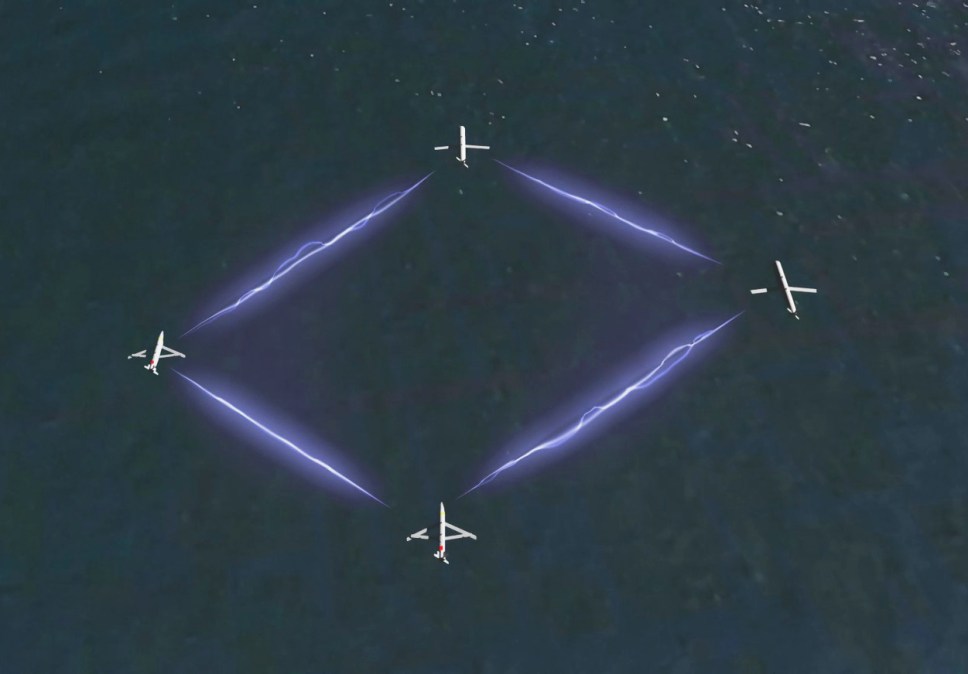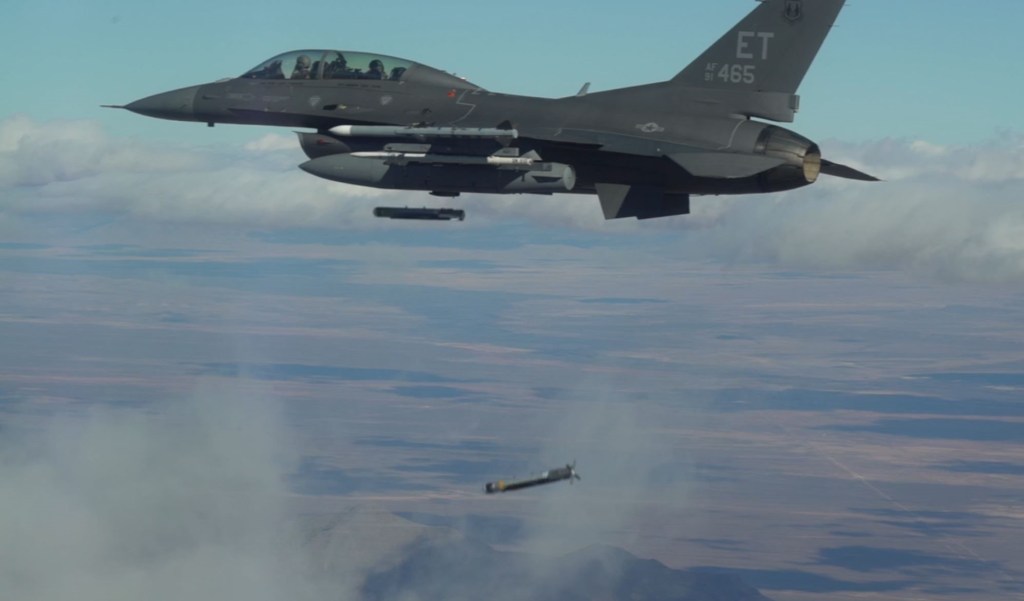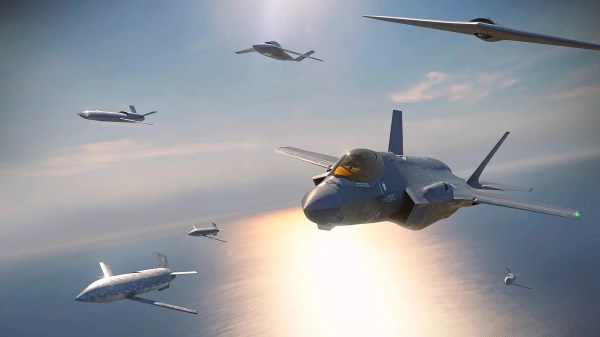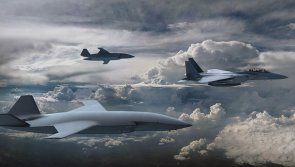Air Force positions autonomous drones, networked weapon systems as top priorities

The Air Force is asking Congress for more than $100 million in additional R&D funding for autonomous drones and networked weapon systems as the Pentagon pursues more cost-effective ways to match up against China.
The technology is a top priority for Air Force leaders as they look toward the future operating environment and fiscal constraints that will limit the number of manned planes that the service can buy for Next-Generation Air Dominance (NGAD) and other programs.
“On its current trajectory, the tactical Air Force is not affordable. The crewed fighters we plan to acquire — F-35, F-15EX and the NGAD platform — are all too costly to fill out our needed force structure as legacy aircraft retire,” Air Force Secretary Frank Kendall said in March at the annual Air Warfare Symposium.
Speaking at the McAleese FY2023 Defense Programs Conference, also in March, Kendall said: “We’ve got to figure out a way to get the capacity, the quantity of capabilities that we need. … You need numbers, particularly if you’re in a situation where you can expect attrition and you need the ability to expand as necessary to deal with the threats. And the higher end, more expensive airplanes are not going to get you there.”
A solution to the problem, officials say, is drones and networked weapon systems.
The Air Force needs a crewed platform “teamed with a much less expensive autonomous uncrewed combat aircraft, employing a distributed tailorable mix of sensors, weapons and other mission equipment operating as a team or formation,” Kendall said.
A slim version of the service’s fiscal 2023 budget request, released March 28, included $113 million for research, development, test and evaluation of unmanned autonomous platforms and “adaptive collaborative platforms,” Deputy Assistant Secretary for Budget Maj. Gen. James D. Peccia III told reporters at the Pentagon.
“Introducing these uncrewed, autonomous and attritable aircraft to the tactical air dominance equation opens up a world of fascinating tactical opportunities.”
Frank Kendall, Secretary of the Air Force
Peccia revealed that much of the money would specifically go toward the Air Force Research Lab’s Skyborg and Golden Horde projects.
These efforts have been designated special Vanguard programs, ranking them among the service’s top science and technology efforts aimed at delivering transformational capabilities to the U.S. military.
Skyborg
The Air Force’s Skyborg program isn’t focused on developing a new drone, but rather an “Autonomy Core System” and an architecture that will enable unmanned platforms to operate as robotic wingmen for manned planes.
The service wants Skyborg technology to be platform agnostic, providing the ability to install autonomy systems — which officials have described as AI-enabled “brains”— on a variety of drones.
“Skyborg has established an open approach to autonomy architecture, building a system that is portable across aircraft platforms, modular in its design to enable composition of multiple software applications, and adaptable to new capabilities and mission types,” according to an AFRL program description.
It continued: “Embedded within the teamed aircraft, complex algorithms and cutting-edge sensors enable the autonomy to make decisions based on established rules of engagement set by manned teammates.”
The lab is working with a number of contractors that are providing unmanned aerial vehicles and other technologies for testing.
Last year, the Air Force tested the Autonomy Core System onboard General Atomics’ MQ-20 Avenger drones during large-scale Orange Flag exercises near Edwards Air Force Base, California.
A key aim was to demonstrate their ability to autonomously fly, navigate, and coordinate safely in environments where manned planes were operating.
One such exercise in October demonstrated ACS capabilities that enabled two MQ-20s to fly autonomously while communicating with each other to ensure coordinated flight, according to AFRL.
More complex Skyborg tests and experiments are in the works.
With money allotted for fiscal 2023, the Air Force Research Lab plans to “continue to mature the foundational technologies in the Autonomy Core System (ACS) and execute operational experimentation to accelerate un-crewed systems development,” an AFRL spokesperson told FedScoop. “Future Skyborg experimentation events will explore direct teaming between crewed aircraft and multiple ACS-controlled un-crewed aircraft.”
Golden Horde
In addition to teaming manned and unmanned aircraft, the Air Force also wants to network its weapons. AFRL’s Golden Horde program is designed to help the service do just that by advancing “networked, collaborative and autonomous” (NCA) weapon capabilities through live and virtual testing.
Using algorithms and data links, munitions can operate and coordinate their actions without human control. That “ultimately enables weapons to react to changes in the environment as well as losses and degradations in their own systems. Although these systems can operate without direct human control, they only engage targets or specific target groups previously selected by a human operator as part of the mission planning process,” according to an AFRL program description.
In 2020, the program achieved the first flight demonstration of NCA capabilities using modified Air Force inventory weapons.
In May of last year, the program conducted the final flight tests of Collaborative Small Diameter Bombs at White Sands Missile Range, New Mexico.
During the event, two F-16 fighter jets simultaneously released their weapons — with four released from one aircraft and two weapons released from the other — and the weapons established communications with each other.
The exercise, which involved more weapons operating in coordination than in previous tests, demonstrated the ability to expand the systems’ radio network and scale up the number of “nodes,” according to an AFRL press release.
The test also involved sending an in-flight target update from a ground station directing the weapons to engage a different target than the one originally assigned.
“The Golden Horde team is blazing an exciting new path for air-delivered weapons,” said AFRL Commander Maj. Gen. Heather Pringle. “These technologies are completely changing the way we think about weapon capabilities, much like the laser-guided bomb did several decades ago. Golden Horde and technologies like this will enable the Department of the Air Force to overcome many of its current and future challenges, and we’re just beginning to unfold all the possibilities.”

Additionally, multiple weapons performed “synchronized time on target” attacks on a single target location, with pairs of weapons conducting such attacks on various target locations.
In September, the program transitioned to a new competitive phase known as Operation Protovision which includes a “Colosseum” where technologies can be showcased in virtual environments and industry teams can compete.
The Air Force is partnering with the Defense Innovation Unit and Johns Hopkins Applied Physics Lab on the effort.
“This virtual environment, a digital engineering pipeline that encompasses software, hardware-in-the-loop and surrogate UAVs, aims to rapidly integrate, develop and test transformational networked, collaborative, and autonomous … weapon capabilities and air platform technologies for future warfighters,” according to an AFRL press release.
Winners of the competitions are slated to conduct live flight demonstrations later this year.
In 2023, the program aims to establish and demonstrate a Software Integration and Simulation Laboratory environment; demonstrate the hardware-in-the-loop environment within the Guided Weapons Evaluation Facility; and continue “weapon autonomy challenges” similar to the current Operation Protovision challenge events, an AFRL spokesperson told FedScoop.
Dogfighting with Robots
AFRL isn’t the only military lab working on robotic wingman technology that could be useful for the Air Force. A Defense Advanced Research Projects Agency (DARPA) initiative called Air Combat Evolution (ACE) is also making headway.
The program made headlines in 2020 during the agency’s AlphaDogfight Trials when artificial intelligence systems beat a human pilot in a series of one-on-one simulated combat engagements.
“We taught robots how to dogfight and then put an Air Force fighter pilot against them and he lost” 5-0, Kenneth Plaks, acting director of DARPA’s Strategic Technology Office, said earlier this month at the annual Sea-Air-Space conference.
“That poor guy is going to be buying beer for the rest of his life in every fighter bar, you know, around the world. [But] he was a good sport about it,” Plaks joked.
The ACE program is shifting into Phase 2.
Work will include developing a more mature AI-driven approach to battle management “where a single pilot can act as a commander for large-scale, collaborative air warfare,” Dynetics, a subsidiary of Leidos, said in a press release.
In February, the company was awarded a $2.6 million contract for the effort.
If Phase 2 is successful, Phase 3 would include a “realistic, manned-flight environment involving complex human-machine collaboration,” according to the release.
One objective of the ACE program is to figure out how to set up manned-unmanned teaming so that human pilots will trust their robotic wingmen.
“I don’t see us removing humans completely from the loop anytime soon. But I can see a future where it’s human on the loop where you’re like, ‘Go take care of that threat and tell me when you’re done.’ And [the AI-enabled platform] just does it,” Plaks said.
Calling Plays
Next-Generation Air Dominance systems, which will include a sixth-generation fighter jet, will be designed to collaborate with uncrewed platforms to increase operational effectiveness, Undersecretary of the Air Force Gina Ortiz Jones told reporters at the Pentagon when the 2023 budget was rolled out.
The service plans to field large numbers of NGAD systems in the 2030s.
Kendall described a “notional” concept of having up to five uncrewed aircraft controlled by a single crewed NGAD platform or an F-35 joint strike fighter.
The idea is for the manned plane to be “essentially calling plays” for the combat drones like a football coach would call plays for their team.
“Introducing these uncrewed, autonomous and attritable aircraft to the tactical air dominance equation opens up a world of fascinating tactical opportunities,” Kendall said.
The Air Force is similarly assessing the potential to introduce lower-cost drones to complement the B-21 strategic bomber as part of a family of systems.
The goal is to have drones with “mission tailorable” levels of capability such as sensors, weapons and other mission payloads.
UAVs that are attritable — meaning their cost is low enough that the Pentagon wouldn’t care too much if they’re destroyed — could even be treated like robotic kamikazes, Kendall suggested, saying they could be “sacrificed if doing so conferred a major operational advantage — something we would never do with a crewed platform.”
The exact mix of crewed and uncrewed aircraft in future air combat teams, what types of payloads individual drones would carry, and what kinds of “plays” could be available for the human operator to select are now being analyzed and defined, he said.
“We’re gonna move forward in that direction and I’m fairly certain of the general path we’re gonna follow in the tactical regime. I’m not as sure of the path in the strategic regime, so we may move a little bit more slowly there. But I think it’s time to do that. I think it’s time to take whatever risk is associated with moving in that direction and trying to get to the first generation of that kind of capability. And then the [greater] numbers will follow,” Kendall said.
The service is looking for drones that are at least 50% less costly than the manned systems that are planned for both the NGAD and B-21 projects, according to Kendall.
The Air Force has not publicly released a cost estimate for NGAD.
The service previously set a cost target for the B-21 at $550 million per plane in fiscal 2010 dollars.
Future programs for manned-unmanned aircraft teaming will build on the work that’s been done for initiatives like Skyborg and ACE, Kendall noted.
“The intent is to cross the Valley of Death [in the acquisition process and make the transition between R&D and large-scale production] and move forward with the fielding of the first instantiation of a program of record that integrates crewed and uncrewed platforms operationally. The assessment we have made is that the technology programs I have discussed … have done enough to build confidence that this goal is achievable,” he said.
The China Challenge
A key driver behind the Air Force’s thrust toward autonomous drones and networked weapon systems is the U.S. military competition with China, which the Pentagon has identified as its “pacing threat.”
Beijing’s anti-access/area-denial capabilities are “very robust”, especially in eastern China and in the South China Sea, Gen. Kenneth Wilsbach, commander of Pacific Air Forces, noted in March at a virtual event hosted by the Mitchell Institute for Aerospace Studies.
When the technology is ready, the majority of U.S. Air Force combat aircraft deployed to the Indo-Pacific theater in the future should be unmanned in order to “stress” Chinese air defenses, he said.
A potential solution to the problem is to have a fleet with a lot of relatively inexpensive, “attritable” unmanned systems that could be employed in combat on a large scale to create challenges for enemy air defense units.
“They use up their resources shooting things that you don’t care that they shoot down,” he said. “That would be a capacity that I’m very interested in as we go into the future of being able to amass targets for them to shoot at.”
While the Pentagon is averse to having its pilots killed, it wouldn’t be as big a deal to U.S. military planners if Chinese forces destroyed robotic platforms.
“If you lose an unmanned aircraft or an uninhabited aircraft, it’s a lot less meaningful to us than [losing] one that’s manned, of course,” Wilsbach said. “The choice that we have to make is how exquisite do we want these unmanned aircraft or uninhabited aircraft to be.”
Having a large fleet of drones that are as capable as high-end manned fighters such as the F-35A, which has a price tag of about $80 million per plane, or the NGAD systems that are under development, would likely be cost-prohibitive, he said
“What I would advocate for is make the manned aircraft exquisite and the uninhabited aircraft to be less exquisite, slightly more attritable, so that we can have more of them,” Wilsbach said. “We don’t want to make these things so expensive that we don’t want to get them shot.”
Future drones could play a variety of roles including acting as a sensor, jammer, “weapons truck,” or simply a decoy designed to draw enemy fire away from more important platforms, he noted.
The systems, enabled by autonomy and artificial intelligence, could coordinate their actions and operate in swarms.
“They should talk to one another and collaborate, not only amongst themselves, but also with the manned platform that they’re supporting,” Wilsbach said.
Manned-unmanned teaming is “the wave of the future,” according to Wilsbach.
He described a hypothetical scenario in which a few NGAD aircraft could be accompanied by 20 to 40 unmanned teammates.
“You give [the Chinese] a lot more targets to have to defend themselves against,” he said.
A key question that the Air Force will have to answer as it builds the future force is what portion of it should be unmanned.
Wilsbach said uncrewed platforms should outnumber crewed systems.
“I would contend that, you know, a 50/50 split wouldn’t be enough,” he said. “Especially inside of the anti-area access … region that China has put up, for every manned platform that you have I’d like to have multiple unmanned platforms that can do a variety of different missions.”
He continued: “The Air Force has not, you know, put down a percentage just yet on what that might look like … but just from what I know from air warfare and creating airpower effects for the joint and combined force, I think we’re going to need a lot more unmanned, many of them attritable, so that you can create the effects that you’re going to be looking for.”
At the McAleese conference, Kendall was asked what portion of the future fleet will be uncrewed.
“I don’t have a number for that but … it is reasonably clear to me that we are poised to go ahead and take a significant step forward in that area,” Kendall said. “I don’t know exactly how long a step that’s going to be, but I’m determined to make it.”






